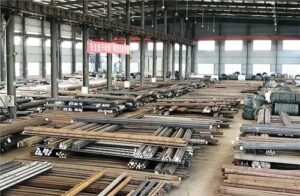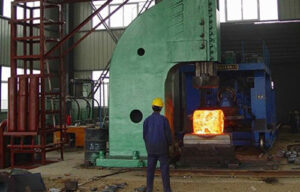Pendahuluan
Baja perkakas kerja panas is a specialized class of steel known for its remarkable ability to maintain strength and durability even when subjected to extreme temperatures. In industries such as manufacturing, forging, and die casting, where high temperatures are the norm, the reliability of materials like hot work tool steel is paramount. In this comprehensive article, we will delve deep into the science behind how hot work tool steel manages to uphold its strength and integrity in the face of searing heat. 1. Understanding Hot Work Tool Steel
1. Understanding Hot Work Tool Steel
1.1 What is Baja Perkakas Kerja Panas?
Baja perkakas kerja panas is a category of steel specifically designed to retain its strength and mechanical properties at elevated temperatures, typically ranging from 600°C (1,112°F) to 1200°C (2,192°F). It is widely used in industries where extreme heat is a constant challenge, such as die casting, forging, and extrusion.
1.2 Composition and Alloying Elements
The composition of hot work tool steel is carefully crafted to provide superior heat resistance. Common alloying elements include chromium, tungsten, molybdenum, and vanadium. These elements contribute to the steel’s ability to maintain its strength in high-temperature environments.
1.3 Properties of Hot Work Tool Steel
Hot work tool steel possesses several key properties that make it an ideal choice for high-temperature applications:
- High Heat Resistance: Hot work tool steel can withstand prolonged exposure to extreme temperatures without significant loss of hardness or strength.
- Exceptional Toughness: It maintains its toughness even when subjected to rapid temperature changes, preventing brittleness or fracture.
- Superior Wear Resistance: Hot work tool steel resists wear and deformation, ensuring durability in demanding conditions.
- Efficient Thermal Conductivity: Good thermal conductivity helps dissipate heat efficiently, preventing localized overheating.
- Dimensional Stability: It retains its shape and dimensions under thermal stress, ensuring precision and consistency.
2. The Mechanism of Strength Retention
Hot work tool steel’s ability to maintain its strength at elevated temperatures is attributed to several key factors:
2.1 Heat-Resistant Alloying Elements
The alloying elements added to hot work tool steel, such as chromium and tungsten, form heat-resistant compounds that remain stable at high temperatures. These compounds contribute to the steel’s heat resistance and mechanical integrity.
2.2 Microstructural Changes
At elevated temperatures, some materials undergo structural changes that can lead to softening or weakening. However, hot work tool steel is engineered to minimize such changes, ensuring that its microstructure remains stable even in extreme heat.
2.3 Thermal Conductivity
Hot work tool steel’s efficient thermal conductivity helps distribute heat evenly throughout the material. This prevents localized overheating and ensures that the entire tool or component retains its strength.

3. Factors Influencing Strength Maintenance
Several factors can influence how hot work tool steel maintains its strength in high-temperature environments:
3.1 Temperature Levels
The specific temperature at which hot work tool steel is used can impact its performance. While it excels in high-temperature applications, extreme temperatures at the upper end of its range may still cause some degradation over time.
3.2 Loading Conditions
The magnitude and type of mechanical loading a tool or component experiences can affect its ability to maintain strength. Proper design and consideration of loading conditions are crucial.
3.3 Tool Design and Maintenance
The design of tools and components, as well as their maintenance, play a significant role in ensuring that hot work tool steel continues to perform optimally in high-temperature environments.
4. Applications in High-Temperature Environments
Hot work tool steel finds extensive use in various industries and applications where elevated temperatures are a constant challenge. Some notable applications include:
4.1 Die Casting
Die casting dies made from hot work tool steel maintain their strength and durability, enabling the production of intricate and high-quality castings.
4.2 Forging
In the forging industry, hot work tool steel is essential for creating dies and tools that shape metals at elevated temperatures, ensuring efficient and precise forging processes.
4.3 Extrusion
Extrusion processes, which involve forcing materials through a die at high temperatures, benefit from hot work tool steel’s durability and heat resistance.
4.4 Plastic Molding
Hot work tool steel is crucial in plastic molding applications, particularly those involving thermoplastics. It withstands the heat generated during the molding process, producing consistent and high-quality plastic parts.
4.5 Aerospace and Automotive Industries
In the aerospace and automotive sectors, where components are exposed to extreme heat during operation, hot work tool steel plays a vital role in maintaining the strength and integrity of critical parts.
5. FAQ: Answering Your Questions
5.1 What is the maximum temperature that hot work tool steel can withstand?
Hot work tool steel can withstand temperatures ranging from 600°C (1,112°F) to 1200°C (2,192°F), depending on the specific grade and composition.
5.2 How does hot work tool steel compare to other materials in terms of heat resistance?
Hot work tool steel excels in heat resistance, maintaining its strength and mechanical properties at elevated temperatures, making it a preferred choice in high-temperature applications.
5.3 Can hot work tool steel’s strength be improved through heat treatment?
Yes, heat treatment processes can be applied to hot work tool steel to further enhance its strength, toughness, and other desired properties for specific applications.
5.4 Are there any limitations to using hot work tool steel in high-temperature applications?
While hot work tool steel is highly effective in high-temperature environments, extreme temperatures at the upper end of its range may lead to some degradation over time. Additionally, it may not be suitable for highly corrosive environments.

